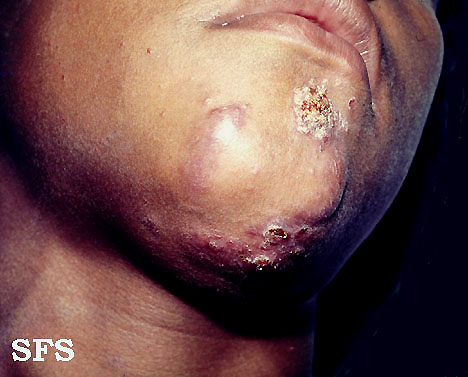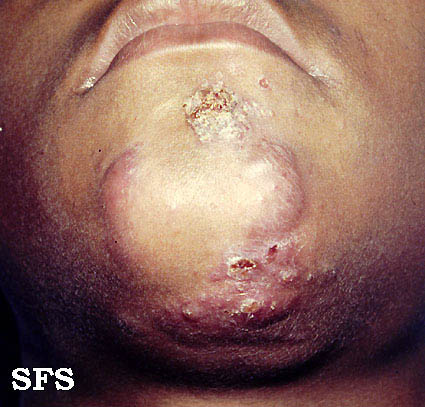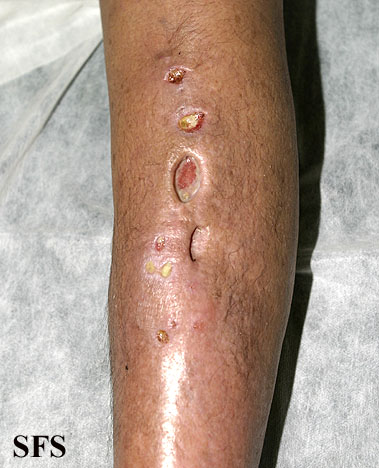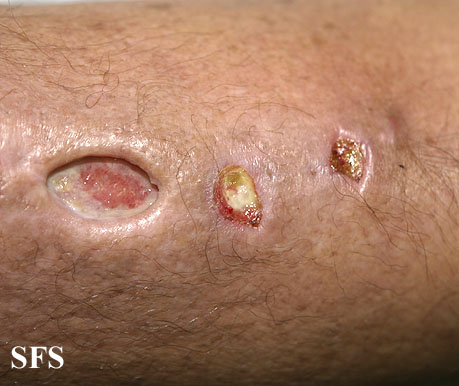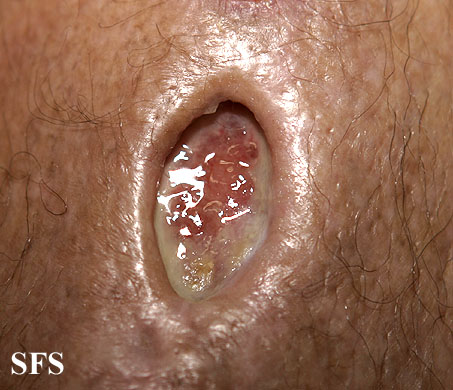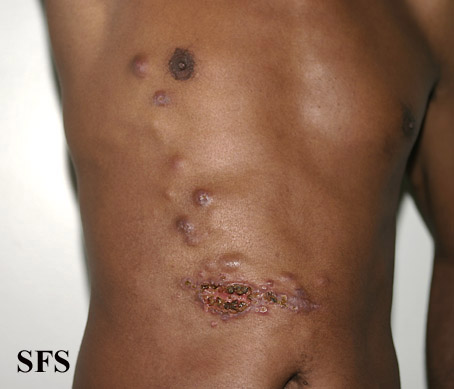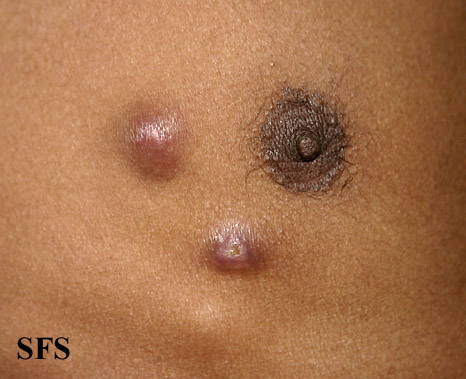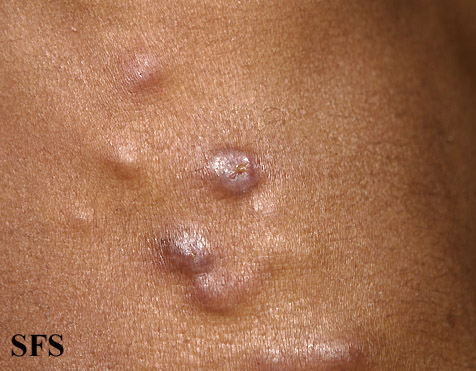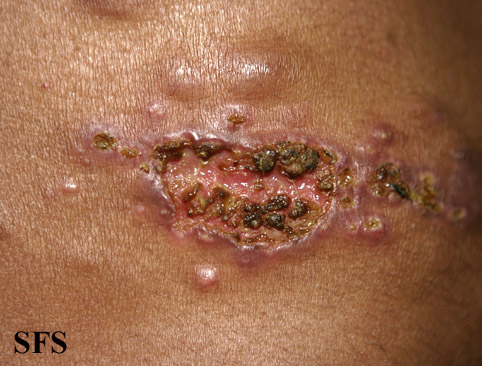Sporotrichosis
|
WikiDoc Resources for Sporotrichosis |
|
Articles |
|---|
|
Most recent articles on Sporotrichosis Most cited articles on Sporotrichosis |
|
Media |
|
Powerpoint slides on Sporotrichosis |
|
Evidence Based Medicine |
|
Clinical Trials |
|
Ongoing Trials on Sporotrichosis at Clinical Trials.gov Trial results on Sporotrichosis Clinical Trials on Sporotrichosis at Google
|
|
Guidelines / Policies / Govt |
|
US National Guidelines Clearinghouse on Sporotrichosis NICE Guidance on Sporotrichosis
|
|
Books |
|
News |
|
Commentary |
|
Definitions |
|
Patient Resources / Community |
|
Patient resources on Sporotrichosis Discussion groups on Sporotrichosis Patient Handouts on Sporotrichosis Directions to Hospitals Treating Sporotrichosis Risk calculators and risk factors for Sporotrichosis
|
|
Healthcare Provider Resources |
|
Causes & Risk Factors for Sporotrichosis |
|
Continuing Medical Education (CME) |
|
International |
|
|
|
Business |
|
Experimental / Informatics |
Editor-In-Chief: C. Michael Gibson, M.S., M.D. [1]; Associate Editor(s)-in-Chief: Jesus Rosario Hernandez, M.D. [2].
Synonyms and keywords:: Rose gardener's.
Overview
Sporotrichosis (also known as "Rose gardener's disease"[1]) is a disease caused by the infection of the fungus Sporothrix schenckii.[2] This fungal disease usually affects the skin, although other rare forms can affect the lungs, joints, bones, and even the brain. Because roses can spread the disease, it is one of a few diseases referred to as rose-thorn or rose-gardeners' disease.[3]
Because S. schenckii is naturally found in soil, hay, sphagnum moss, and plants, it usually affects farmers, gardeners, and agricultural workers.[2] It enters through small cuts and abrasions in the skin to cause the infection. In case of sporotrichosis affecting the lungs, the fungal spores enter through the respiratory pathways. Sporotrichosis can also be acquired from handling cats with the disease; it is an occupational hazard for veterinarians.
Sporotrichosis progresses slowly - the first symptoms may appear 1 to 12 weeks (average 3 weeks) after the initial exposure to the fungus. Serious complications can also develop in patients who have a compromised immune system.
Forms and symptoms
- Cutaneous or skin sporotrichosis
- This is the most common form of this disease. Symptoms of this form include nodular lesions or bumps in the skin, at the point of entry and also along lymph nodes and vessels. The lesion starts off small and painless, and ranges in color from pink to purple. Left untreated, the lesion becomes larger and look similar to a boil and more lesions will appear, until a chronic ulcer develops.
- Usually, cutaneous sporotrichosis lesions occur in the finger, hand, and arm.
- Pulmonary sporotrichosis
- This rare form of the disease occur when S. schenckii spores are inhaled. Symptoms of pulmonary sporotrichosis include productive coughing, nodules and cavitations of the lungs, fibrosis, and swollen hilar lymph nodes. Patients with this form of sporotrichosis are susceptible to developing tuberculosis and pneumonia
- Disseminated sporotrichosis
- When the infection spreads from the primary site to secondary sites in the body, the disease develops into a rare and critical form called disseminated sporotrichosis. The infection can spread to joints and bones (called osteoarticular sporotrichosis) as well as the central nervous system and the brain (called sporotrichosis meningitis).
- The symptoms of disseminated sporotrichosis include weight loss, anorexia, and appearance of bony lesions.
Sporotrichosis in animals
Sporotrichosis can be diagnosed in domestic and wild mammals. In veterinary medicine it is most frequently seen in cats and horses. Cats have a particularly severe form of cutaneous sporotrichosis and also can serve as a source of zoonotic infection to persons who handle them and are exposed to exudate from skin lesions.
Diagnosis
Sporotrichosis is a chronic disease with slow progression and often subtle symptoms. It is difficult to diagnose, as many other diseases share similar symptoms and therefore must be ruled out.
Patients with sporotrichosis will have antibody against the fungus S. schenckii, however, due to variability in sensitivity and specificity, it may not be a reliable diagnosis for this disease. The confirming diagnosis remains culturing the fungus from the skin, sputum, synovial fluid, and cerebrospinal fluid.
Cats with sporotrichosis are unique in that the exudate from their lesions may contain numerous organisms. This makes cytological evaluation of exudate a valuable diagnostic tool in this species. Exudate is pyogranulomatous and phagocytic cells may be packed with yeast forms. These are variable in size, but many are cigar-shaped.
Prevention
The majority of sporotrichosis cases occur when the fungus is introduced through a cut or puncture in the skin while handling vegetation containing the fungal spores. Prevention of this disease includes wearing long sleeves and gloves while working with soil, hay bales, rose bushes, pine seedlings, and sphagnum moss.
Physical examination
Gallery
Skin
Head
Extremities
Trunk
Treatment
Treatment of sporotrichosis depends on the severity and location of the disease. The following are treatment options for this condition:[4]
- Saturated potassium iodide solution
- Although its mechanism is unknown, application of potassium iodide in droplet form can cure cutaneous sporotrichosis. This usually requires 3 to 6 months of treatment.
- Itraconazole (Sporanox) and fluconazole
- These are antifungal drugs. Itraconazole is currently the drug of choice and is significantly more effective than fluconazole. Fluconazole should be reserved for patients who cannot tolerate itraconazole.
- This antifungal medication is delivered intravenously. Many patients, however, cannot tolerate Amphotericin B due to its potential side effects of fever, nausea, and vomiting.
Lipid formulations of amphotericin B are usually recommended instead of amphotericin B deoxycholate because of a better adverse-effect profile. Amphotericin B can be used for severe infection during pregnancy. For children with disseminated or severe disease, amphotericin B deoxycholate can be used initially, followed by itraconazole.[5]
- In case of sporotrichosis meningitis, the patient may be given a combination of Amphotericin B and 5-fluorocytosine/Flucytosine.
- Newer triazoles
Several studies have shown that posaconazole has in vitro activity similar to that of amphotericin B and itraconazole; therefore, it shows promise as an alternative therapy. However, voriconazole susceptibility varies. Because the correlation between in vitro data and clinical response has not been demonstrated, there is insufficient evidence to recommend either posaconazole or voriconazole for treatment of sporotrichosis at this time.[5]
- In cases of bone infection and cavitatory nodules in the lungs, surgery may be necessary.
Antimicrobial Regimen
- Sporotrichosis[6]:
- Lymphocutaneous/cutaneous
- Preferred regimen: Itraconazole 200mg PO/day
- Alternative regimen: Itraconazole 200 mg PO bid OR Terbinafine 500 mg bid OR Saturated solution potassium iodide(SSKI) with increasing doses OR Fluconazole 400–800 mg/day OR local hyperthermia
- Note(1): Treat for 2–4 weeks after lesions resolved
- Note(2): SSKI initiated at a dosage of 5 drops (using a standard eyedropper) 3 times daily, increasing as tolerated to 40–50 drops 3 times daily
- Osteoarticular
- Preferred regimen: Itraconazole 200mg PO bid for 12 monthes
- Alternative regimen: Lipid amphotericin B (Lipid AmB) 3–5 mg/kg/day OR Amphotericin B deoxycholate 0.7–1 mg/kg/day
- Note(1): Switch to Itraconazole after favorable response if AmB used
- Note(2): Treat for a total of at least 12 months
- Pulmonary
- Preferred regimen(1): Lipid amphotericin B (Lipid AmB) 3–5 mg/kg/day, then Itraconazole 200 mg PO bid
- Preferred regimen(2): Itraconazole 200 mg PO bid
- Alternative regimen: Amphotericin B deoxycholate 0.7–1 mg/kg/d, then Itraconazole 200 mg PO bid OR surgical removal
- Note(1): Treat severe disease with an AmB formulation followed by Itraconazole
- Note(2): Treat less severe disease with Itraconazole
- Note(3): Treat for a total of at least 12 months
- Meningitis
- Preferred regimen: Lipid amphotericin B (Lipid AmB) 5 mg/kg/day, then Itraconazole 200 mg PO bid
- Alternative regimen: Amphotericin B deoxycholate 0.7–1 mg/kg/d, then Itraconazole 200 mg PO bid
- Note(1): Length of therapy with AmB not established, but therapy for at least 4–6 weeks is recommended.
- Note(2): Treat for a total of at least 12 months.
- Note(3): May require long-term suppression with Itraconazole.
- Disseminated
- Preferred regimen: Lipid amphotericin B (Lipid AmB) 3–5 mg/kg/day, then Itraconazole 200 mg PO bid
- Alternative regimen: Amphotericin B deoxycholate 0.7–1 mg/kg/day, then Itraconazole 200 mg PO bid
- Note(1): Therapy with AmB should be continued until the patient shows objective evidence of improvement.
- Note(2): Treat for a total of at least 12 months.
- Note(3): May require long-term suppression with Itraconazole.
- Pregnant women
- Preferred regimen(1): Lipid amphotericin B (Lipid AmB) 3–5 mg/kg/day OR Amphotericin B deoxycholate 0.7–1 mg/kg/day for severe sporotrichosis
- Preferred regimen(2): Local hyperthermia for cutaneous disease.
- Note: It is preferable to wait until after delivery to treat non–life-threatening forms of sporotrichosis.
- Children
- Mild disease
- Preferred regimen: Itraconazole 6–10 mg/kg/day (400 mg/day maximum)
- Severe disease
- Preferred regimen: Amphotericin B deoxycholate 0.7 mg/kg/day
- Alternative regimen: Saturated solution potassium iodide(SSKI) with increasing doses for mild disease
References
- ↑ Rapini, Ronald P.; Bolognia, Jean L.; Jorizzo, Joseph L. (2007). Dermatology: 2-Volume Set. St. Louis: Mosby. ISBN 1-4160-2999-0.
- ↑ 2.0 2.1 Ryan KJ, Ray CG (editors) (2004). Sherris Medical Microbiology (4th ed.). McGraw Hill. pp. 654–6. ISBN 0-8385-8529-9.
- ↑ Volk T. "Sporothrix schenckii, cause of Rose-picker's Disease". Tom Volk's Fungus of the Month. Retrieved 2007-06-16.
- ↑ Lortholary O, Denning DW, Dupont B (1999). "Endemic mycoses: a treatment update". J. Antimicrob. Chemother. 43 (3): 321–31. doi:10.1093/jac/43.3.321. PMID 10223586.
- ↑ 5.0 5.1 Hogan BK, Hospenthal DR. Update on the therapy for sporotrichosis. Drug Benefit Trends. 2010;22:49-52.
- ↑ Kauffman, C. A.; Bustamante, B.; Chapman, S. W.; Pappas, P. G. (2007). "Clinical Practice Guidelines for the Management of Sporotrichosis: 2007 Update by the Infectious Diseases Society of America". Clinical Infectious Diseases. 45 (10): 1255–1265. doi:10.1086/522765. ISSN 1058-4838.
Complications
Cutaneous lesions can become superinfected with bacteria, resulting in cellulitis.
